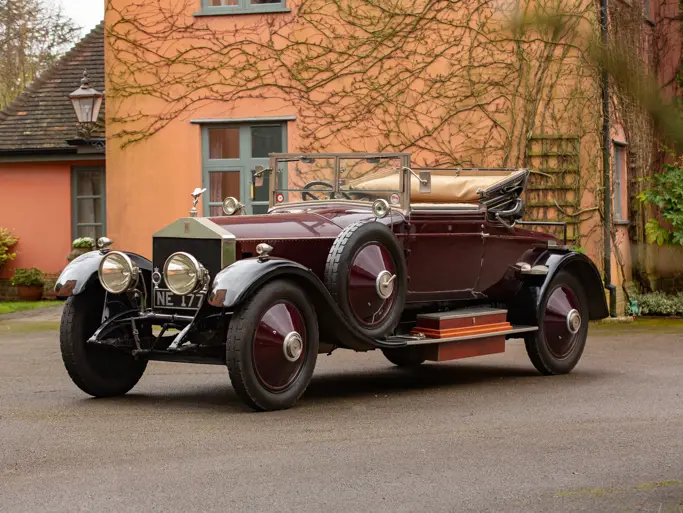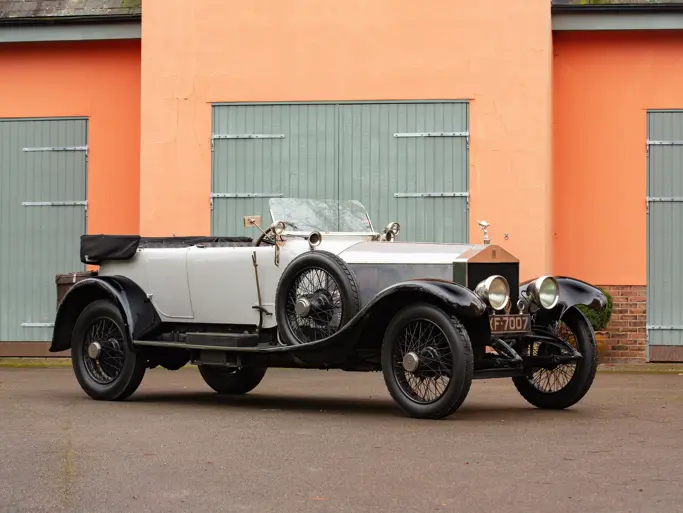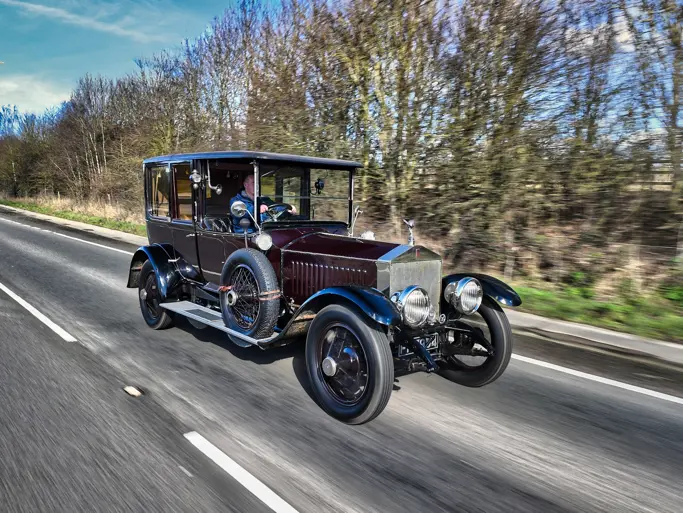40/50 hp, 7,428 cc L-head six-cylinder engine, three-speed manual transmission, solid front axle with semi-elliptic leaf springs, live rear axle with three-quarter elliptic leaf springs, and two-wheel mechanical brakes. Wheelbase: 142.5"
• Prized early prewar Silver Ghost with attractive Roi-des-Belges coachwork
• Ex-Millard Newman Collection
• History documented in John Fasal’s The Edwardian Rolls-Royce
• Award-winning restoration
Introduced to great acclaim, the Rolls-Royce model first introduced in 1906 was not initially referred to as a Silver Ghost but rather the “40/50,” referring to its 40 taxable horsepower and 50 true horsepower. The first 40/50 to bear the name Silver Ghost was actually the 13th chassis built. It featured an aluminum body by Barker with silver-plated exterior fittings and a silver-plated brass plate bearing the name “Silver Ghost.” The name stuck and Silver Ghosts became known not only for their incredible reliability but also for their virtually silent operation, smoothness and absence of vibration. As stated in a 1911 sales catalogue: “The Rolls-Royce Car is bought by people who will have the best and nothing but the best.” Production continued in England through 1925 and in America at Rolls-Royce’s Springfield facility from 1921 to 1926.
The aforementioned 13th chassis became a demonstration car for Rolls-Royce, and it was first put to the test in a 2,000-mile trial under the supervision of the Royal Automobile Club. During this test, the car recorded a figure of better than 20 mpg on the road between London and Glasgow—quite astounding considering the size of the vehicle with such a large engine (7,036 cc). Next, the car was entered into the Scottish Reliability Trials. Unfortunately, the Rolls had to make an unscheduled stop at 629 miles caused by a faulty petrol tap shaking shut. The car continued to run flawlessly day and night following the trials, resting only on Sundays, until 15,000 miles had been covered; thus, 14,371 miles were travelled without an involuntary stop, setting a new world record. The car was then dismantled under the supervision of the R.A.C., with all parts reported “as new.” A Silver Ghost simply did not wear out, especially when compared to its contemporaries.
Chassis no. 1574, the desirable prewar example offered here, was completed and placed on test March 3, 1911 and shipped on April 24. Its history is documented in the definitive Silver Ghost book, The Edwardian Rolls-Royce by John Fasal, which confirms the car was delivered new with Cabriolet coachwork by Alford & Alder. It was delivered new to Mr. N. Gatti in London, who kept the car until 1919. Subsequent owners include Mr. W.F. Hawkes of London, who sold it in 1925 to Dr. J.M. Lees of Leeds. In 1946, no. 1574 was in the care of Wing Commander M.W. Anderson of Doncaster.
As is often the case with prewar Ghosts, 1574 lost its original Alford & Alder body and was fitted with a Roi des Belges-style body after the war.
In 1958, San Diego collector R.E. Tyson bought 1574 from Anderson, importing it into the United States. He removed the Roi des Belges body, and by 1986 the car was part of the well-known collection of Silver Ghost aficionado Millard Newman in Florida. By this time, it was fitted with a lovely original Roi des Belges-type body by Alford & Alder. While there is no way to know which chassis originally carried the body now fitted to chassis no. 1574, it is an original Alford & Alder body that has been expertly restored.
The initial restoration was undertaken by the late Mr. Newman, who commissioned noted U.K. Rolls-Royce restorer David Hemmings to carry out a careful refurbishment. Upon completion of this work, the car earned an AACA National Senior award at the AACA National Fall Meet at Hershey in 1996.
Since Mr. Newman’s ownership, the car has been treated to a comprehensive program of upgrades and renovation, carried out by noted Silver Ghost expert Steve Littin. The body was completely restored to American concours standards, new fenders were fitted, and the engine and transmission were completely rebuilt, resulting in a car that has toured nearly 2,000 trouble free miles since completion.
Following the restoration, the car was honored with a number of prestigious awards at various concours events, including Amelia Island, Hilton Head, Meadow Brook and RROC events.
Finished in Garnet Red, with black trim and gold pinstriping, the car is trimmed in rich tan leather with tan top, tonneau and side curtains. It is simply one of the most striking Silver Ghosts extant. The coachwork is accented with flawlessly restored brass brightwork.
The car is extremely well-equipped, with magnificent French-made BRC headlamps and a matched set of Lucas “King of the Road” lamps, a pair of #754 side lamps and a pair of #632 tail lamps, each fitted with a custom fleece-lined canvas cover. Other accessories include a Boa bulb horn, a correct period Klaxon and a 100-mph Smiths speedometer with odometer. In addition, the car is fitted with an exhaust cut-out (marked “Not for use in the U.K.”), a proper brass-plated tilting windshield with accessory rear view mirrors and a radiator cap mounted with a period RAC member’s badge.
The attention to detail exhibited by 1574 is remarkable. It is proper and correct in every respect other than the installation of a modern starter motor and associated electrical system, which makes starting a painless and simple task. Silver Ghosts are remarkable automobiles, and none are more highly prized than these early “parallel bonnet” cars. Given the exceptional quality, undeniable beauty and fascinating provenance of these cars, they represent exceptional value in today’s market. Ghost owners love their cars, and consequently they are rarely offered for sale. Looking at the stunning example offered here, it is easy to understand why.




 | Boca Raton, Florida
| Boca Raton, Florida


